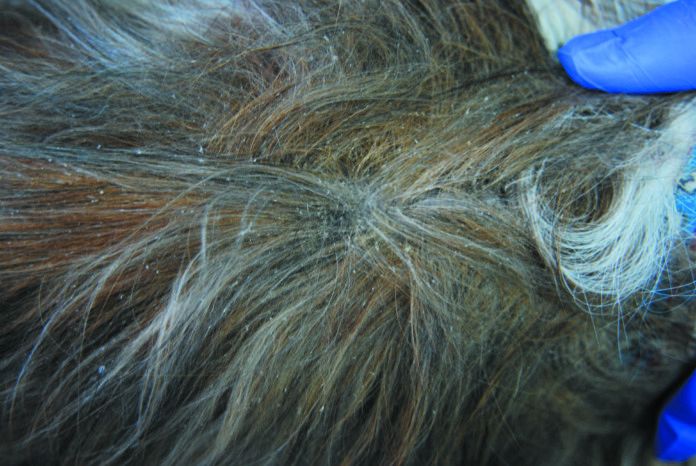If you see excessive dandruff on your dog’s body, he’s not unkempt. Rather, something has gone awry.
“This is not about observing mild dandruff on a black dog — any white flecks on black hair are probably going to show,” says Tufts veterinary dermatologist Ramón Almela, DVM. “The stress of visiting the vet can also trigger transient dandruff production, which is nothing to be concerned about,” Dr. Almela says. But if you otherwise see dandruff scales on your pet,
something about his health is off.
How dandruff forms
The skin consists of three distinct layers, but it’s the top visible layer — the epidermis — where the problem of dandruff occurs.
The epidermis is composed of cells called keratinocytes. These cells are completely renewed every three to four weeks, just as in people. At the end of the cycle, the cells die and slough off.
It all happens microscopically. Millions of cells get released individually every single day, and millions of new cells replace them. The process is finely regulated by a very precise mechanism — unless something goes wrong. That’s when you have dandruff: abnormal scaling, or scaffolding, of different cells. The cells stick together to create small sheets that remain on the skin’s surface instead of sloughing off individually.
Why skin sloughing goes wrong
There are three main reasons dandruff develops.
1. Genetic propensity. A number of genetic “defects” can interfere with the process of cell sloughing. For instance, certain proteins that regulate the life of cells are deficient or don’t work properly, and the result is abnormal renewal of the epidermis layer of the skin. It’s call ichthyosis. “Ichthys” is Greek for “fish,” which have scales.
Breeds predisposed include Golden retrievers, West Highland white terriers, American bulldogs, Jack Russell terriers, Norfolk terriers, and King Charles cavalier spaniels. People tend to notice a problem within the first few months of the dog’s life. It often starts on the abdomen (where there is less hair, making the dandruff easier to see), but occurs all over the trunk.
2. Dietary imbalance. The process of proper skin cell turnover is actually very demanding from a nutritional point of view. Think about it: the dog has to renew his entire top layer of skin every three to four weeks. It requires a lot of good-quality protein and essential fatty acids. If something is missing or out of balance with other nutrients, dandruff can ensue.
In breeds with especially fast growth — great Danes, Doberman pinschers, Rhodesian ridgebacks — a zinc deficiency could interfere with proper skin cell turn-over. This might especially be the case if a dog is fed a home-cooked diet that has not been developed by a board-certified veterinary nutritionist. The skin cells tend to remain in big sheets or plates that are easily seen with the naked eye.
3. Underlying disease. A number of diseases might cause accelerated renewing, a situation in which the cells of the epidermis renew too quickly before maturing completely. They therefore become attached to each other in small plates. The most common underlying disease that would cause dandruff is inflammatory skin disease. When the skin is inflamed, it throws off the entire process of epidermis renewal.
The inflammation can come from an allergy (such as a flea allergy) or a reaction to mites, for example. Whatever the cause, too-quick cell turnover occurs on top of the inflammation. You can’t see the inflammation — just the white flakes.
Identifying the culprit
A veterinarian will check for inflammation on the skin or lesions — breaks in the skin’s normally smooth surface. If he confirms that there’s inflammation, he will search for the cause. Once the inflammation is tended to, the dandruff will disappear.
If the skin is not inflamed, the next step is to consider whether there might be a nutrient deficiency or imbalance. Switching the diet, or sometimes adding fat to a home-cooked diet under the supervision of a board-certified veterinary nutritionist, should resolve the dandruff issue if a poor diet is causing the problem.
If it turns out the dandruff is the result of a genetic disorder, you won’t be able to take away the problem. But with a veterinary dermatologist’s oversight, you can increase bathing (to as much as once a week) to remove the scales or perhaps use a medicated dog shampoo to help take care of the dandruff depending on what type it is (dry or oily). In some dogs, polyunsaturated fatty acids applied to the skin can help, Dr. Almela says. Assiduous brushing can prove useful, too. Rest assured that if the problem is genetic, the dandruff, while unsightly, will not hurt the dog. It’s only when the dandruff comes from an underlying disease or a nutrition problem that you have to take action.






We’ve been fighting this on a 69 lb fit, age 5.5 black lab mix for a couple of months now. No major dietary changes, highly rated kibble, some no-salt added veggies, tablespoon or two of burger, chicken, fish on top with Omega-3 supplements. Vet suggested a spray-on oatmeal based conditioner. He also said less frequent bathing but skin seems a bit oily to us and more frequent bathing works better. Fulminator also is very effective. Last bath we tried the 5 min. 50/50 apple cider vinegar rinse before the hand shower with oatmeal/aloe shampoo. Finally seeing slow improvement, but disappointed the Vet couldn’t do a better diagnosis and offered to send us to a pet dermatologist which runs several hundred bucks in our area. My human dermatologist is jealous…